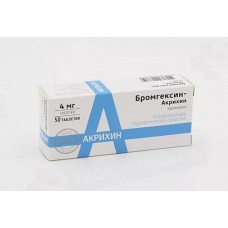Expiration date: 05/2026
Dosage form: pills, drops for oral administration, solution for injection, solution for oral administration, syrup, syrup [for children], tablets, tablets [for children]
Pharmacological action: Mucolytic (secretolytic) agent, has expectorant and weak antitussive effect. Reduces the viscosity of sputum (depolymerizes mucoprotein and mucopolysaccharide fibers, increases the serous component of bronchial secretion), activates the shimmering epithelium, increases the volume and improves the discharge of sputum. It stimulates the production of endogenous surfactant, ensuring the stability of alveolar cells during respiration. The effect appears in 2-5 days from the beginning of treatment.
Indications: Diseases of the respiratory tract, accompanied by difficulty of discharge of viscous sputum: tracheobronchitis, bronchitis of different etiology (including complicated bronchiectasis), asthma, pulmonary tuberculosis, pneumonia (acute and chronic), cystic fibrosis. Sanation of the bronchial tree in the preoperative period and during therapeutic and diagnostic intrabronchial manipulations, prevention of accumulation of thick viscous sputum in the bronchi after surgery.
Contraindications: Hypersensitivity, peptic ulcer, pregnancy (I trimester), lactation, childhood (up to 6 years - for tablet forms).C caution. Renal and/or hepatic insufficiency, bronchial diseases accompanied by excessive accumulation of secretions, a history of gastric bleeding.
Side effects: Allergic reactions, nausea, vomiting, dyspepsia, exacerbation of gastric ulcer and duodenal ulcer, dizziness, headache, increased activity of "hepatic" transaminases (extremely rare).
Overdose: Symptoms: nausea, vomiting, diarrhea, dyspeptic disorders. Treatment: artificial vomiting, gastric lavage (in the first 1-2 hours after administration).
Dosage and administration: Bromhexine is taken orally (syrup, tablets and pills - for children over 6 years, drops, oral solution), adults and children over 14 years - 8-16 mg 3-4 times a day. Children under 2 years - 2 mg 3 times a day, 2-6 years - 4 mg 3 times a day, 6-14 years - 8 mg 3 times a day. If necessary, the dose can be increased to 16 mg adults 4 times a day. In the form of inhalations (solution for inhalations) adults - 8 mg, children over 10 years - 4 mg, 2-10 years - 2 mg. Inhalations are carried out 2 times a day. The solution is diluted with distilled water 1:1 and heated to body temperature to prevent coughing. With bronchial obstruction before inhalation, it is necessary to prescribe bronchodilator drugs. Bromhexine 8-drops: inside, adults and adolescents over 14 years - 23-47 cap 3 times a day, children 6-14 years and patients weighing less than 50 kg - 23 cap 3 times a day, up to 6 years - 12 cap 3 times a day. Therapeutic effect may appear on 4-6 days of treatment. Parenteral (I/m, n/a, in/in slowly for 2-3 min) 2-4 mg 2-3 times a day. The solution for I/V administration should be diluted with ringer's solution or sterile water for injection. Patients with renal insufficiency are prescribed smaller doses or increase the interval between injections.
Special instructions: In the treatment it is necessary to take a sufficient amount of liquid, which increases the expectorant effect of Bromhexine. In children, treatment should be combined with postural drainage or vibrational chest massage, facilitating the removal of secretions from the bronchi. Note that the composition Bromhexine 8-drop included ethanol (41 vol.%).
Interaction: Bromhexine is not prescribed simultaneously with drugs, suppressing the cough center (including codeine), as this makes it difficult to discharge liquefied sputum (accumulation of bronchial secretion in the respiratory tract). Incompatible with alkaline solutions. Bromhexine promotes the penetration of antibiotics (amoxicillin, erythromycin, cephalexin, oxytetracycline), sulfanilamide drugs into the bronchial secret in the first 4-5 days of antimicrobial therapy.




